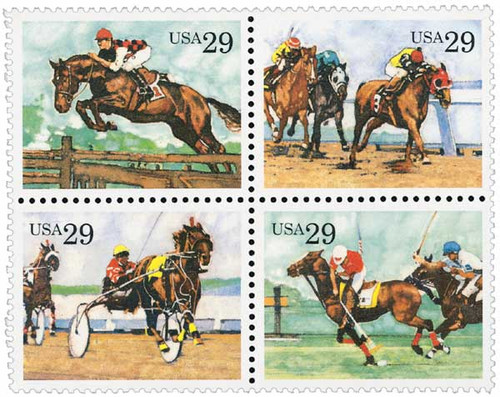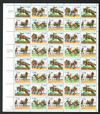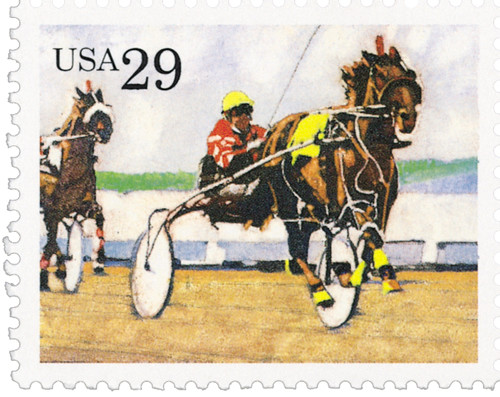
# 2756-59 - 1993 29c Sporting Horses
1993 29¢ Sports Horses
City: Louisville, KY
Quantity: 40,000,000
Secretariat Wins The Triple Crown
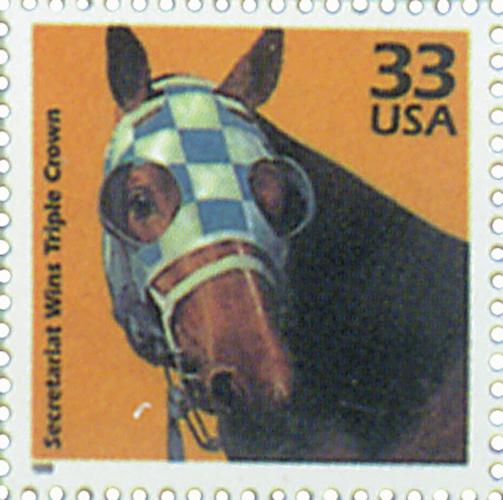
On June 9, 1973, Secretariat won the Belmont Stakes race, becoming the first U.S. Triple Crown winner in 25 years.
The son of the successful stallion Bold Ruler, Secretariat was born on March 30, 1970. He remained unnamed for a year, but was eventually named Secretariat by the stable’s secretary.
Secretariat began training in 1972. However, he was awkward and more interested in eating than running. Over time he grew more focused and fast and managed to finish fourth in his first race in July 1972. He then won five races in a row, including the Sanford Stakes and Hopeful Stakes at Saratoga Race Course, and the Futurity Stakes at Belmont Park. During one of those races he passed eight horses in just a quarter mile and won by five lengths. At the end of his first year racing, Secretariat won the Eclipse Award for American Champion Two-Year-Old Male Horse and American Horse of the Year.
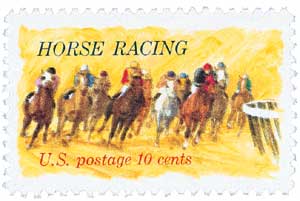
Secretariat then prepared for his most memorable season. He began 1973 with a win at the Bay Shore Stakes. Then on May 5, 1973, he competed in the Kentucky Derby. Although he broke last, he quickly caught up and eventually won the race by two-and-a-half lengths. Secretariat ran each quarter mile segment faster than the one before it and won the race in under two minutes – which had never been done before and wouldn’t be done again until 2001. As one sportswriter recalled, “No one had ever seen anything run like that… It was like he was some other animal out there.”
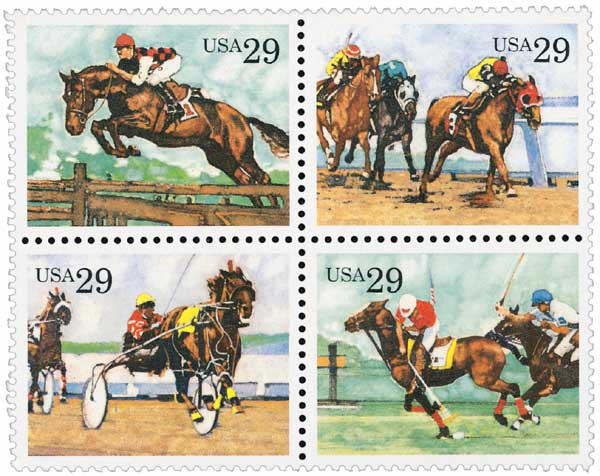
Two weeks later Secretariat appeared at the Preakness Stakes on May 19. Once again, he started in last place. But in the first turn he managed to go from last to first and went on to win the race by two-and-a-half lengths again. His exact time has long been disputed, as the various timers all reported differing numbers. In 2012 the Maryland Racing Commission looked at old videotapes and listened to over two hours of testimony before settling on a time of 1:53, which was the state’s record.
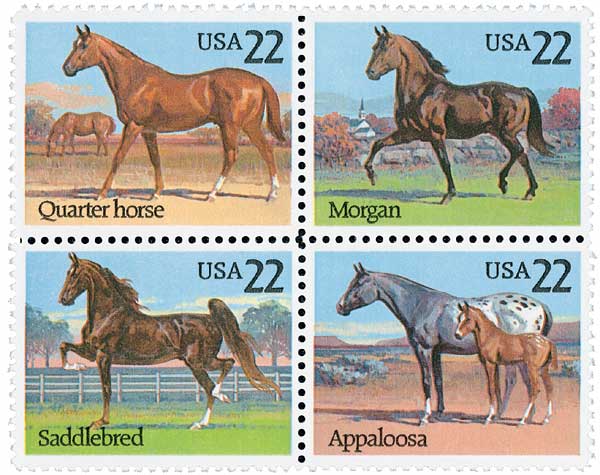
After these two victories, Secretariat prepared for the Belmont Stakes, the final victory needed to win the Triple Crown. In the coming weeks he was featured on the covers of three national magazines: Time, Newsweek, and Sports Illustrated. Secretariat quickly became a celebrity and household name.

On June 9, 1973, Secretariat and four other horses competed at the 105th Belmont Stakes in front of a crowd of 67,605. Secretariat was the favorite, though he was racing Sham, who’d finished second in each of the previous races. Secretariat and Sham began the race fast – ten lengths ahead of the other horses. But along the backstretch Sham could no longer maintain their break-neck pace and, exhausted, fell to last place. The announcer excitedly proclaimed, “Secretariat is widening now! He is moving like a tremendous machine!” Secretariat continued to expand his lead on the other racers, eventually winning by 31 lengths (breaking the previous record of 25). He also ran the fastest race on dirt – one-and-a-half miles in 2:24 flat. This was two seconds faster than the previous record, and is still the record today, exactly 43 years later.
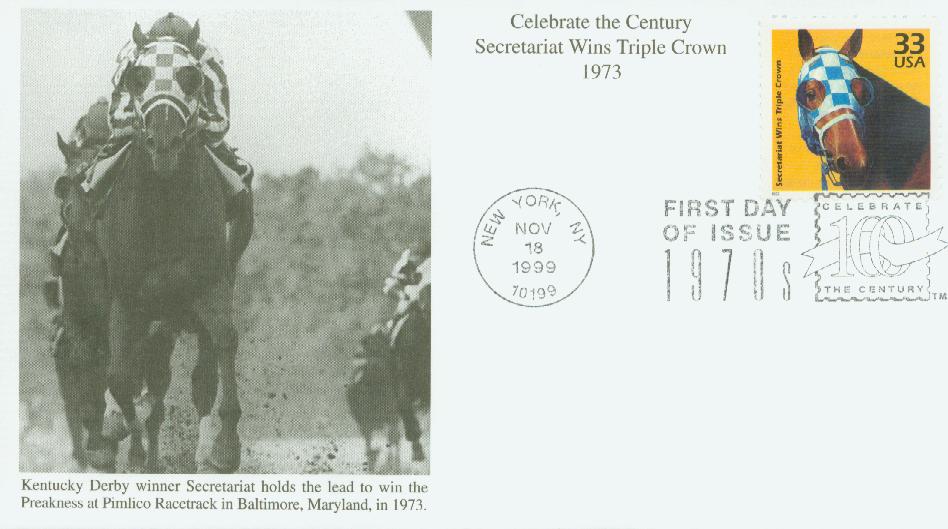
Many considered this race to be one of the best by a 20th century North American racehorse. Secretariat was the ninth Triple Crown winner and the first in 25 years. He continued to race for the rest of the year, winning the Arlington Invitational, Marlboro Cup, Man o’ War Stakes, and Canadian International. In all, Secretariat won 16 of his 21 career races, and finished second three times and third once. At the end of 1973 he was again named horse of the Year and won Eclipse Awards as the American Champion Three-Year-Old Male Horse and the American Champion Male Turf Horse.
Secretariat retired after 1973 and sired a number of other successful racehorses, about 600 in all. He died at age 19 on October 4, 1989.
Click here to watch video of Secretariat’s Triple Crown races.
1993 29¢ Sports Horses
City: Louisville, KY
Quantity: 40,000,000
Secretariat Wins The Triple Crown

On June 9, 1973, Secretariat won the Belmont Stakes race, becoming the first U.S. Triple Crown winner in 25 years.
The son of the successful stallion Bold Ruler, Secretariat was born on March 30, 1970. He remained unnamed for a year, but was eventually named Secretariat by the stable’s secretary.
Secretariat began training in 1972. However, he was awkward and more interested in eating than running. Over time he grew more focused and fast and managed to finish fourth in his first race in July 1972. He then won five races in a row, including the Sanford Stakes and Hopeful Stakes at Saratoga Race Course, and the Futurity Stakes at Belmont Park. During one of those races he passed eight horses in just a quarter mile and won by five lengths. At the end of his first year racing, Secretariat won the Eclipse Award for American Champion Two-Year-Old Male Horse and American Horse of the Year.

Secretariat then prepared for his most memorable season. He began 1973 with a win at the Bay Shore Stakes. Then on May 5, 1973, he competed in the Kentucky Derby. Although he broke last, he quickly caught up and eventually won the race by two-and-a-half lengths. Secretariat ran each quarter mile segment faster than the one before it and won the race in under two minutes – which had never been done before and wouldn’t be done again until 2001. As one sportswriter recalled, “No one had ever seen anything run like that… It was like he was some other animal out there.”

Two weeks later Secretariat appeared at the Preakness Stakes on May 19. Once again, he started in last place. But in the first turn he managed to go from last to first and went on to win the race by two-and-a-half lengths again. His exact time has long been disputed, as the various timers all reported differing numbers. In 2012 the Maryland Racing Commission looked at old videotapes and listened to over two hours of testimony before settling on a time of 1:53, which was the state’s record.

After these two victories, Secretariat prepared for the Belmont Stakes, the final victory needed to win the Triple Crown. In the coming weeks he was featured on the covers of three national magazines: Time, Newsweek, and Sports Illustrated. Secretariat quickly became a celebrity and household name.

On June 9, 1973, Secretariat and four other horses competed at the 105th Belmont Stakes in front of a crowd of 67,605. Secretariat was the favorite, though he was racing Sham, who’d finished second in each of the previous races. Secretariat and Sham began the race fast – ten lengths ahead of the other horses. But along the backstretch Sham could no longer maintain their break-neck pace and, exhausted, fell to last place. The announcer excitedly proclaimed, “Secretariat is widening now! He is moving like a tremendous machine!” Secretariat continued to expand his lead on the other racers, eventually winning by 31 lengths (breaking the previous record of 25). He also ran the fastest race on dirt – one-and-a-half miles in 2:24 flat. This was two seconds faster than the previous record, and is still the record today, exactly 43 years later.

Many considered this race to be one of the best by a 20th century North American racehorse. Secretariat was the ninth Triple Crown winner and the first in 25 years. He continued to race for the rest of the year, winning the Arlington Invitational, Marlboro Cup, Man o’ War Stakes, and Canadian International. In all, Secretariat won 16 of his 21 career races, and finished second three times and third once. At the end of 1973 he was again named horse of the Year and won Eclipse Awards as the American Champion Three-Year-Old Male Horse and the American Champion Male Turf Horse.
Secretariat retired after 1973 and sired a number of other successful racehorses, about 600 in all. He died at age 19 on October 4, 1989.
Click here to watch video of Secretariat’s Triple Crown races.

